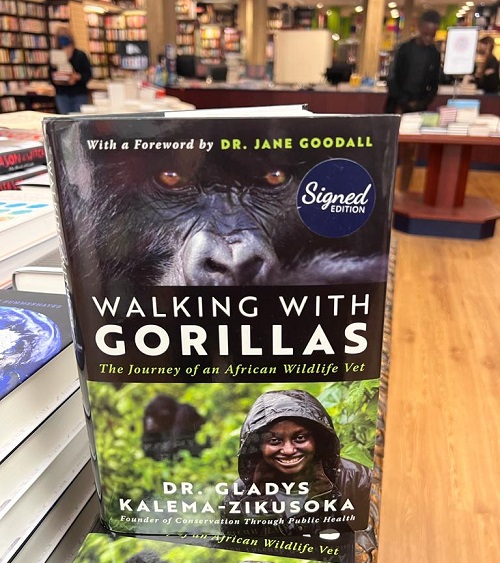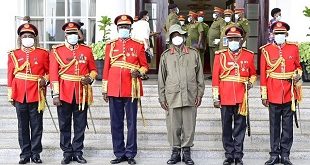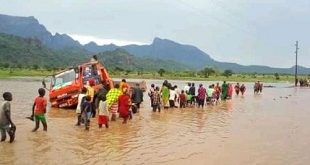
Kampala, Uganda | ISAAC KHISA | Uganda’s first wildlife veterinarian and founder of non-governmental organisation, Conservation Through Public Health (CTPH), Dr. Gladys Kalema Zikusooka, has unveiled her memoir ‘Walking with Gorillas’ detailing her childhood experience, dream job, marriage and sustainable conservation.
The memoir launched at the Kampala Serena Hotel on July.05 consists of four parts each revealing a vital aspect of her journey towards becoming a wildlife veterinarian and founder of CTPH.
In the first part of the memoir, Dr. Kalema recounts her childhood experiences that compelled her to become a wildlife veterinarian. Growing up as the youngest of six children, she was devastated after her father was abducted and assassinated by General Idi Amin soldiers.
This tragic event profoundly influenced her early years, and this ignited a strong determination to continue her father’s vision of developing Uganda. As the youngest among her siblings, she had limited opportunities to interact with children her own age, so she sought solace and escape through animals, particularly her beloved pet dog Poppy and a stray cat named Pilli.
Despite the widespread cultural belief that animals lacked souls, Dr. Kalema felt a deep connection to them and mourned their loss. Her mother’s relationship with their neighbors, the Cuban Ambassador and his wife, introduced her to Poncho, their pet vervet monkey which sparked her interest in primates and together with the pets at home ultimately influenced her decision to pursue a career in veterinary medicine at the age of twelve.
Despite the perception that veterinary medicine as not being valuable career in Uganda, she claims to have remained resolute in her determination to dedicate her life to the conservation of Ugandan wildlife, which has been severely affected by heavy poaching under the Idi Amin regime.
Dr. Kalema says she first learnt about the mountain gorillas of Bwindi through Wildlife Clubs. She went on to revive the Kibuli Secondary School wildlife club. She was fortunate to secure a place at the Royal Veterinary College in London. Throughout her university years, Dr Kalema encountered various difficulties, but she persevered and gained practical experience in working with wildlife.
Finally, the long-awaited opportunity to visit and study the mountain gorillas in Bwindi arose but unfortunately illness prevented her from interacting with them initially. Nevertheless, she eventually had the chance to trek and observe the gorillas, and conduct research on intestinal parasites and bacteria, forming a deep connection with these majestic creatures.
Following her accomplishments Dr. Kalema says she reached out to Dr. Edroma, the director of National Parks expressing her desire to become the first veterinarian for Uganda National Parks. To her surprise he responded and told her that her dream job would be waiting for her after she completed her studies.
Becoming a Wildlife Veterinarian
In the second part of the memoir titled ‘Becoming a Wildlife Veterinarian,’ Dr. Kalema recounts her experiences in her dream job where she encountered major challenges including relocating elephants but despite her lack of experience, she successfully relocated them demonstrating that elephants, an endangered species are important enough in Uganda to be translocated rather than killed. Her next hurdle involved tackling a mysterious skin disease affecting giraffes, which was diagnosed as filariasis.
Dr. Kalema also achieved the unprecedented feat of relocating giraffes from Kenya to Uganda demonstrating the value of translocating animals as a means of restoring wildlife populations. Just nine months into her job, Dr. Kalema faced another challenge when mountain gorillas contracted an unusual skin disease and a baby gorilla died of the disease. Diagnosed as scabies, she administered treatment and discovered that the group had been exposed through dirty clothing on scarecrows used to scare the gorillas from their banana plants. This experience would inspire her to start an NGO seven years later to address human health and seek a solution where human and gorilla community could live in harmony.
She recounts her endeavors in developing the first health education program with local communities in Uganda linking the health of people and wildlife. After completing many workshops with local communities, she realized that she couldn’t keep gorillas healthy without improving the health and well-being of local communities and she started to think about setting up an NGO that improved the health of wildlife and people together.
One Health and Marriage
In this part, Dr. Kalema describes her move to the US which was both exciting, and rather intimidating. A highlight of the move, she says, was that soon after arriving in the US, she and Lawrence reconnected – long after meeting briefly at her cousin’s wedding – and quickly fell in love.
Woven through the story of their early romance and plans for marriage, are details of Dr. Kalema’s first forays into a career in the One Health field, both through residency at North Carolina State University and North Carolina Zoo and through studying disease transmission between people, wildlife and livestock around Bwindi and Queen Elizabeth National park.
In this part of the memoir, Dr. Kalema also describes her decision to establish Conservation Through Public Health as an NGO in Uganda and the many early challenges she and others faced as they sought to promote understanding for the need for an integrated response to conservation and health, fundraise for their work and establish a presence with very little available funding.
This section also looks at the early progression of Dr Kalema’s work establishing Conservation Through Public Health, detailing the milestones, successes and difficulties along the way. It also explains the evolution of the organization and its work, including developing a community centered and driven One Health model; establishing the first telecentre of its kind in Bwindi and later in Queen Elizabeth National Park; the introduction of family planning into the CTPH programs; the development of Village Health and Conservation Teams; engaging of young people; and later taking on advocacy and influencing policy, amongst other activities.
This section also describes Dr. Kalema’s burgeoning recognition as an entrepreneur and leader in her field and in including serving on the boards of Uganda Wildlife Education Centre and Uganda Wildlife Authority. CTPH’s gradual and exciting expansion from Bwindi to other gorilla and wildlife habitats.
Sustaining Conservation
Part four of Dr. Kalema’s memoir takes a look at the future of conservation and describes ways in which it can be supported in sustainable ways which move away from donor dependence. Eco-tourism is one route which Dr. Kalema discusses; as well as describing the conservation and social contributions of CTPH’s social enterprise, Gorilla Conservation Coffee.
She notes that COVID-19 pandemic was a pivotal moment for the entire World and, not least, for conservation – highlighting the need to identify new, sustainable ways to fund conservation. In Bwindi, where livelihoods were so heavily dependent on tourism for income, an immediate increase in poaching and illegal activity was witnessed following the restrictions on travel and tourism in a bid to reduce COVID-19 transmission.
There was also a major risk posed to the gorillas from COVID-19 so this section deals with this very stressful period during the height of the COVID pandemic experienced by Dr Kalema and her team as they strived to mitigate COVID-19 transmission to the gorillas including successfully advocating for mask wearing by people coming into close contact with mountain gorillas.
Dr. Kalema’s own personal battles with COVID are detailed in this section too. The COVID pandemic did shine more light on the work of CTPH though, forcing people to take the issue of zoonotic disease spread more seriously and lending support to One Health approaches as solutions. The section, and book, ends on a hopeful note, acknowledging that the increased Global recognition of One Health approaches has raised Dr. Kalema’s and CTPH’s profile further, helping the organisation to achieve more, as she also looks to the future to encourage more people – especially women and young people and especially in Africa – to walk a conservation path.
Stakeholders congratulates Dr. Kalema for the memoir
Philippe Groueix, the General Manager at Total Energies Uganda which is currently developing oil and gas project in Tilenga in the Albertine Graben congratulated Dr. Kalema for launching her memoir.
“I personally share a passion for the rich and diverse wildlife and landscapes of Uganda and I am inspired by Dr. Kalema’s story as well as the work of CTPH in its mission to promote biodiversity conservation,” he said during the book launch at the Kampala Serana Hotel on July.05.
“We realise how wildlife, humans and ecosystems are interconnected. At TEPU, conservation and community development are cornerstone activities of Tilenga oil project and are undertaken through our various biodiversity and social development programs.”
Lilly Ajarova, the chief executive officer at Uganda Tourism Board said “Dr Gladys Kalema is a brand … As you know, our premium product is the gorilla. Gladys has made a great contribution besides doing her work of treating Mountain Gorillas.”
The US Ambassador to Uganda, Natalie Brown who was the guest of honour said “the book an engaging lesson for all and useful information on the importance of conservation and its connection to health. The US is proud to support efforts to preserve the environment and Uganda’s biodiversity for future generations.
Gorillas, according to Uganda Tourism Board, remain the single most important item on Uganda’s tourism sector
 The Independent Uganda: You get the Truth we Pay the Price
The Independent Uganda: You get the Truth we Pay the Price


